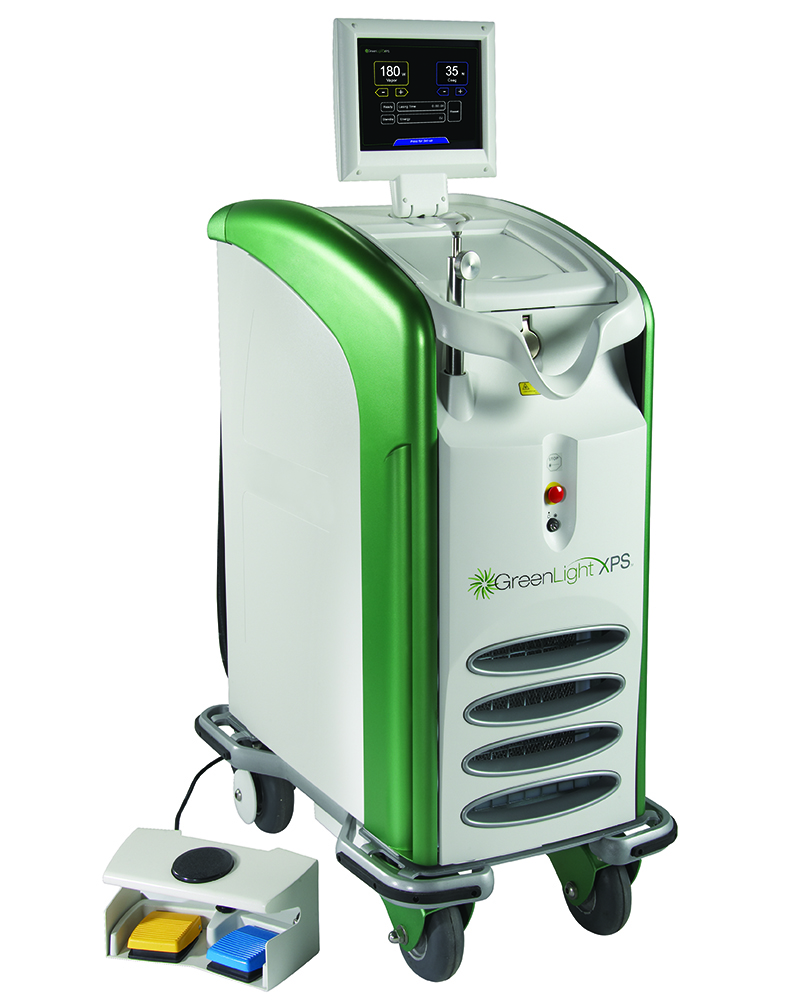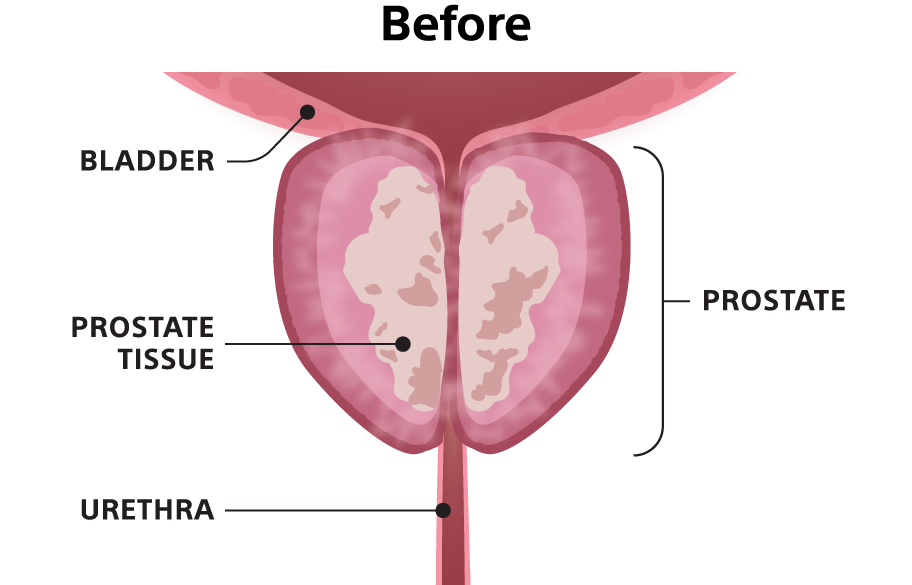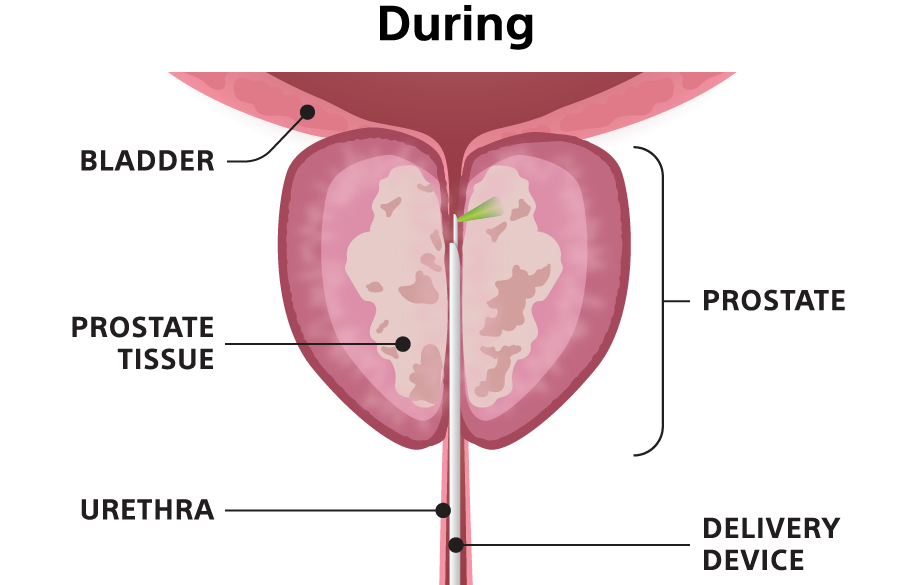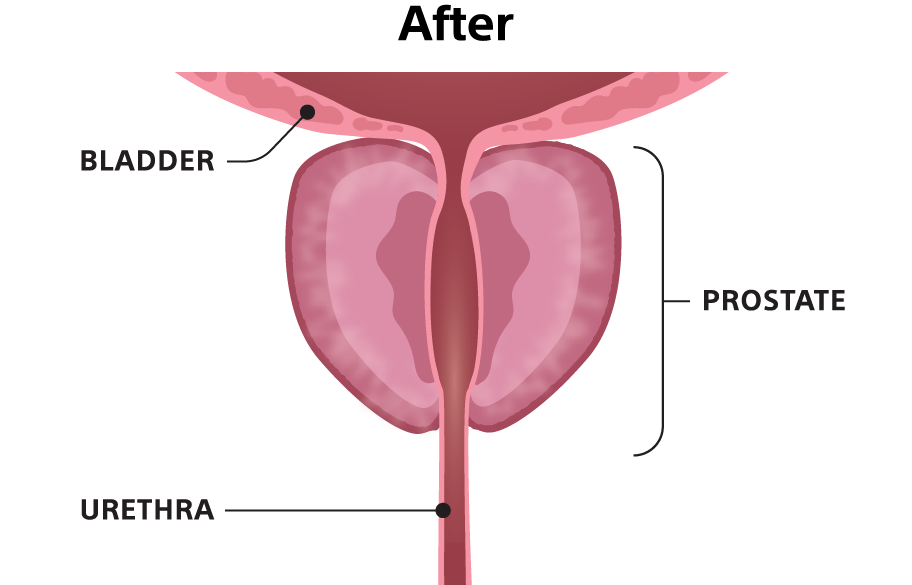GreenLight™ Laser Therapy

Introduction
An enlarged prostate can mean frequent trips to the bathroom and interrupted sleep. Medicines for this condition may not work that well, can be expensive and may have unpleasant side effects.
If this sounds like you, it’s time to take action. There are more treatment options today than ever before.
GreenLight Laser Therapy has helped hundreds of thousands of men similar to you gain relief from frustrating BPH symptoms affecting their lives and the people closest to them.
We hope you find this page informative and that it helps you find the right treatment option for your condition. If you have additional questions, please be sure to ask your doctor.
Lasers are now used in many areas of medicine, including eye2 and cosmetic surgery.3 They are also used to treat an enlarged prostate.4
During the GreenLight procedure, the tissue blocking your prostate is rapidly heated and vaporized. Natural urine flow is rapidly restored in most patients.
Typically, the procedure is performed as a same-day surgery. Many patients can go home without a urinary catheter. An overnight stay may be recommended for some patients.
When medicine isn’t enough
Alternative treatment options
Typically, medicines are first used to treat an enlarged prostate. However, sometimes drugs don’t provide enough symptom relief. Or the side effects can be bothersome. Drugs can be expensive. Or there may be other reasons medical therapy for BPH isn’t right for you.
Fortunately, there are alternatives. Surgical methods to treat an enlarged prostate include:
Transurethral resection of the prostate (TURP) – This procedure involves use of a heated wire to cut tissue from the prostate and has been used to treat an enlarged prostate for years.
Open surgery – This procedure involves removal of the inner part of the prostate through an incision made in the abdomen.
Other types of lasers – In addition to GreenLight Laser Therapy, other systems remove enlarged prostate tissue through the use of high-energy lasers. Clinically documented laser therapies have become a viable treatment option.5
Transurethral microwave therapy (TUMT) – In this therapy, a microwave antennae mounted on a catheter is used to heat the prostate and open up the blockage.
Advantages of GreenLight Laser Therapy
Compared with traditional surgical options, GreenLight Laser Therapy is associated with:
- Significantly less chance of severe blood loss6
- Same-day surgery in most cases7
- Significantly faster recovery in typical cases for the following:6,8-11
- Shorter hospital stay
- Shorter catheterization time
- Less bleeding
- Comparable risks and outcomes
What happens during the GreenLight procedure?
The following is intended as a general overview. Your experience may differ. Please talk to your doctor about potential risks and questions you may have about the procedure.



- Before treatment begins, you may be asked to empty your bladder.
- You will then be brought into the procedure room and moved to the treatment bed where you will lie on your back. Your doctor may give you medication to help you relax.
- The procedure is typically performed under general anesthesia. This means that you will be asleep during the procedure. A different type of anesthesia may be used, depending on the treatment center.
- Once the anesthesia takes effect, your doctor will insert a small scope into your urethra. The scope allows your doctor to see the inner surfaces of the urethra, prostate and bladder.
- After the scope is in place, your doctor will advance the laser device through the scope to the location of the enlarged prostate tissue.
- Your doctor will then vaporize the prostate tissue that is obstructing urine flow. Dead tissue that is not immediately vaporized will be passed naturally in your urine during the first few days after your surgery.
- A temporary urinary catheter may be placed at the end of the procedure to let urine drain from your bladder.
After the procedure
People typically go home within a few hours after the procedure. You should arrange for a ride home.
If a urinary catheter was placed in your bladder at the end of the procedure, it will typically be removed within 24 hours. However, some patients may require a catheter for a longer time.
Most patients experience very rapid relief of symptoms and a dramatic improvement in urine flow. This usually occurs within 24 hours of the procedure. Your experience may differ.
Your doctor will provide you with specific discharge instructions and information on signs and symptoms that may require further medical attention.
You may experience mild discomfort such as slight burning during urination and see small amounts of blood in your urine for a week or so. Also, depending on the condition of your bladder, you may experience greater frequency and urge to urinate. This will likely resolve over time.
Usually, you can return to your everyday activities within a short time after the GreenLight procedure. If you have any questions, ask your doctor.
Risks
Every surgical procedure may have risks. The same is true for GreenLightTM Laser Therapy.
The most common risks include:
- Hematuria – Blood in the urine
- Irritation of the bladder – Results in frequent and/or urgent need to urinate
- Irritation of the urethra – Frequent urination, burning sensation
- Retrograde ejaculation – Semen during sexual climax travels backward to the bladder rather than exiting through
the penis
At doctor’s instruction, some patients taking blood-thinners can be treated with GreenLight Laser Therapy without stopping their medicines.12
Tried and tested technology
GreenLightTM Laser Therapy has been well documented and numerous articles have been published about the therapy in medical literature.
Based on these articles, GreenLight Laser Therapy:
- Has low complication rates6, and short catheterization6,8-11,13-14 and hospitalization times.6,8-11,14
- Can be used if you are taking blood thinners12, in urinary retention15, or have a large prostate (>100 ml).8
- Can be used if you have an implanted pacemaker, defibrillator, or neurostimulator.16
Next steps
You can get back to your life without the hassles of remembering to take BPH or enlarged prostate pills, dealing with side effects, and paying for prescriptions.
Talk to your doctor to see if GreenLight Laser Therapy is right for you. It just might be the best choice for symptom relief from an enlarged prostate.
It’s time to take action and get measurable results – without medications.
Frequently asked questions
Resources
We understand how important it is to get answers to questions that you might have about prostate health. The following resources can help you learn more about advances in the diagnosis and treatment of an enlarged prostate.
GreenLightTM Laser Therapy patient website
You can find a wealth of information about GreenLight Laser Therapy on our website at:
- Take a quiz to gauge the degree of your condition
- Find a local urologist
- Learn more about BPH and find additional educational resources
Urology Care Foundation
The Urology Care Foundation is the official foundation of the American Urological Association and provides extensive information on prostate health on its website at:
National Kidney and Urologic Diseases Information Clearinghouse (NKUDIC)
This website is sponsored by the National Institute of Diabetes and Digestive and Kidney Diseases (NIDDK), National Institutes of Health (NIH). In addition to basic information on an enlarged prostate, you will find links to the latest research and statistics on prostate health at:
Commonly used terms
Benign prostatic hyperplasia (BPH): A non-cancerous enlargement of the prostate.
Bladder: Hollow organ in the lower abdomen that stores urine.
Catheter: A flexible tube for withdrawing fluids from (or introducing fluids into) a cavity of the body, especially for inserting into the bladder, through the urethra, to remove urine.
Ejaculation: The release of semen from the male reproductive system.
Erectile dysfunction: Inability to develop or maintain an erection.
Hematuria: Blood in the urine.
Impotence: Inability to maintain an erection and/or the inability to ejaculate.
Incontinence: Loss of control of the bladder. Can range from minor leakage to total inability to control bladder function.
Laser energy: A highly concentrated, very intense beam of light energy that can create high temperatures.
Prostate: Gland in males located in front of the rectum and below the bladder. The main function of the prostate is to transport sperm during ejaculation.
Retrograde ejaculation: Semen travels backward to the bladder during sexual climax rather than exiting through the penis.
TUMT: Treatment for an enlarged prostate that uses heat to treat an enlarged prostate. Stands for transurethral microwave therapy.
TURP: Common surgical treatment for an enlarged prostate. Stands for transurethral resection of the prostate.
Urethra: Tube that connects the urinary bladder to the genitals for the removal of fluids from the body.
Urinary urgency: A sudden, compelling urge to urinate.
References
- Data on file with Boston Scientific.
- Munnerlyn CR. Lasers in ophthalmology: Past, present and future. J Mod Opt. 2003;50:2351-60.
- Hruza GJ, Dover JS. Laser skin resurfacing. Arch Dermatol. 1996 Apr;132(4):451-5.
- McVary KT, Roehrborn CG, Avins AL, et al. Update on AUA guideline on the management of benign prostatic hyperplasia.
J Urol. 2011 May;185(5):1793-803. - Hueber PA, Zorn KC. Canadian trend in surgical management of benign prostatic hyperplasia and laser therapy from 2007-2008 to 2011-2012. Can Urol Assoc J. 2013 Sep-Oct;7(9-10):E582-6.
- Bachmann A, Tubaro A, Barber N, et al. 180-W XPS GreenLight laser vaporization versus transurethral resection of the prostate for the treatment of benign prostatic obstruction: 6 month safety and efficacy results of the European multi-centre randomized trial – The GOLIATH Study. Eur Urol. 2014 May;65(5):931-42.
- Garnick MB. 2013 Annual Report on Prostate Diseases. Boston, MA: Harvard Health Publications; 2013.
- Lukacs B, Loeffler J, Bruyère F, et al. Photoselective vaporization of the prostate with GreenLight 120-W laser compared with monopolar transurethral resection of the prostate: A multicenter randomized controlled trial. Eur Urol. 2012 Jun;61(6):1165-73.
- Capitán C, Blázquez C, Martin MD, et al. GreenLight HPS 120-W laser vaporization versus transurethral resection of the prostate for the treatment of lower urinary tract symptoms due to benign prostatic hyperplasia: A randomized clinical trial with 2-year follow-up. Eur Urol. 2011 Oct;60(4):734-9.
- Al-Ansari A, Younes N, Sampige VP, et al. GreenLight HPS 120-W laser vaporization versus transurethral resection of the prostate for treatment of benign prostatic hyperplasia: a randomized clinical trial with midterm follow-up. Eur Urol. 2010 Sep;58(3):349-55.
- Bouchier-Hayes DM, Van Appledorn S, Bugeja P, et al. A randomized trial of photoselective vaporization of the prostate using the 80-W potassium titanylphosphate laser vs transurethral prostatectomy, with a 1-year follow-up. BJU Int. 2010 Apr;105(7):964-9.
- Sohn JH, Choi YS, Kim SJ, Effectiveness and safety of photoselective vaporization of the prostate with the 120 W HPS GreenLight laser in benign prostatic hyperplasia patients taking oral anticoagulants. Korean J Urol. 2011 Mar;52(3):178-83.
- Ahyai SA, Gilling P, Kaplan SA, et al. Meta-analysis of functional outcomes and complications following transurethral procedures for lower urinary tract symptoms resulting from benign prostatic enlargement. Eur Urol. 2010 Sep;58(3):384-97.
- Pereira-Correia JA, de Moraes Sousa KD, Santos JB, et al. GreenLight HPSTM 120-W laser vaporization vs transurethral resection of the prostate (<60 mL): A 2-year randomized double-blind prospective urodynamic investigation. BJU Int. 2012 Oct;110(8):1184-9.
- Woo H, Reich O, Bachmann A, et al. Outcome of GreenLight HPS 120W laser therapy in specific patient populations: those in retention, on anticoagulants, and with large prostates (≥ 80 ml). Eur Urol. 2008;7(Suppl):378-83.
- GreenLight XPSTM Laser System Operator’s Manual, Part No. 0010- 0240 Rev. C. November 2010.
- Barry M, Roehrborn C. Management of benign prostatic hyperplasia. Ann Rev Med. 1997 Feb;48:177-189.
All surgical treatments have inherent and associated risks. The GreenLightTM Laser System is intended for removal of soft tissue, including vaporization of the prostate for benign prostatic hyperplasia (BPH). Potential risks include irritative symptoms, bleeding, retrograde ejaculation and urinary tract infection. You should talk with your doctor about benefits and risks before moving forward with any treatment option.
All trademarks are the property of their respective owners.
